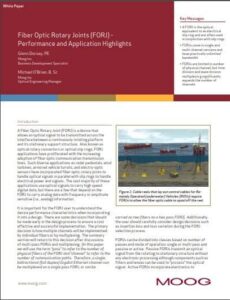 Moog, a leading manufacturer of precision motion control devices and systems for unmanned vehicles and robotics, has released a whitepaper outlining how to choose the right Fiber Optic Rotary Joint (FORJ) configurations for specific application needs, in order to achieve reliable optical data transfer.
Moog, a leading manufacturer of precision motion control devices and systems for unmanned vehicles and robotics, has released a whitepaper outlining how to choose the right Fiber Optic Rotary Joint (FORJ) configurations for specific application needs, in order to achieve reliable optical data transfer.
Download the whitepaper from Moog’s website
Fiber Optic Rotary Joints allow an optical signal to be transmitted across the interface between a continuously rotating platform and its stationary support structure. FORJ applications have escalated with the adoption of fiber optic communication transmission lines, offering practically unlimited bandwidth. While most FORJ applications use optical signals to carry high speed digital data, they are also able to carry analog data with frequency or amplitude sensitive information.
FORJ can be used in a wide range of UAV (unmanned aerial vehicle) and unmanned systems applications, such as vehicle turrets, electro-optic sensors, and in parallel with slip rings to handle electrical power and signals.
To ensure a cost-effective and successful implementation, it is important to understand the specific configurations required, early in the FORJ design and selection process. The Moog whitepaper provides details of:
Single Pass vs. Multi-Pass
The primary decision when choosing FORJ is how to implement multiple channels: by individual fibers or by multiplexing. From a mechanical perspective, multi-pass FORJs are generally larger and more complex than single-pass FORJs because of the mechanisms required to provide rotary alignment of multiple fibers.
In single pass FORJs, a single fiber enters the FORJ on either side of the rotating interface, and optical signals are coupled between them as one fiber rotates relative to the other. The most common approach is the use of lenses to expand the optical beam, thereby minimizing the effects of mechanical misalignment.
In a case of a multi-pass FORJ, multiple fibers enter the FORJ on either side of the rotating interface. Optical signals are coupled only between specific pairs of fibers across the rotating interface and, because of this, a multi-pass FORJ can transmit multiple independent data streams across the rotating interface, even when optical multiplexing is not used. Multi-pass FORJs are available in a number of differing configurations: lens-based, de-rotating prism-based and mirror-based cell.
Passive vs. Active FORJs
Passive FORJs transmit an optical signal from the rotating to stationary structure without any electronic processing although components such as filters and lenses can be used to “process” the optical signal. Passive FORJs have become standard catalog devices and have found uses in widespread applications.
Active FORJs incorporate electronics to process the signal to improve rotor to stator transmission properties and can involve electrical / optical conversion, amplification, signal conditioning and re-clocking. Active devices are used primarily with applications requiring a through-bore, such as the medical CT scanner, where an active FORJ has been implemented to carry high speed image data from the rotating X-ray detectors of the sensor array to the stationary data processors.
When to Consider Multiplexing
Often a more cost effective approach to adding optical passes is to use multiplexing, which adds effective channels of information without adding physical passes. Multiplexing, be it wavelength division multiplexing or time division multiplexing, takes advantage of the almost unlimited bandwidth of a single fiber by placing multiple signals on a single (or reduced number of) physical optical pass. The net effect of decreasing the number of physical passes is to reduce the size, cost, and weight of the FORJ without an additional performance decrement on the signal.
It is important to carefully consider the best trade-off of multiplexing and physical passes when establishing both the mechanical and electrical architecture of the system. The appropriate configuration will ultimately depend on specific application and environmental needs along with the type of data transmission required. To find out more, download the full whitepaper from Moog’s website.


















